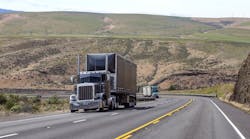“Beyond being a large, unavoidable business expense, fuel is an owner-operator’s biggest controllable expense,” according to part one of a 12-part series of articles on fuel from ATBS.
I would say that statement is true not just for owner-operators but also for fleets of all sizes. Fuel is a big part of operating a truck, but it is also something that fleets can control. Larger fleets, of course, can negotiate fuel prices so may have an advantage in the at-the-pump price, but everyone can achieve fuel-economy gains by making a commitment to do so and acting on that commitment.
In the past, I have talked about things fleets can do to help control their fuel costs as well as explaining why even when fuel prices are low it is a good idea to be mindful of ways to reduce fuel costs.
But I think now is a good time for a little reminder because the Energy Information Administration’s Summer Fuels Outlook, predicts nationwide retail diesel prices could reach $2.96 a gallon. This is up from the $2.43 a gallon diesel cost in the summer of 2020. That is a significant increase so fleets and owner-operators will feel the impact to their bottom line. While even fleets that have already taken action to improve fuel efficiency will feel a pinch, the impact will be less than for those fleets who have not focused on fuel economy because recently fuel prices have been low.
The good news is that it is never too late to start focusing on improving fuel economy. There are a variety of add-on devices that fleets can invest in that will lead to fuel economy improvements while at the same time offering a favorable ROI — especially as fuel prices rise.
If you don't have the budget for add-on devices, there are still no-cost options that will help you get more miles per gallon. The first is resetting electronic engine parameters to optimize for fuel economy. While it can take some time to get the parameters set across the fleet, savings in the 5% to 8% range are possible when all parameters are optimized for fuel economy. Adjusting just a few key parameters — vehicle speed and idle reduction — can lead to fuel savings in the 3% to 5% range. Other than your time, resetting parameters doesn’t cost you anything.
The other free fuel economy improver is the driver. Depending on who you talk to, drivers can have as much as a 30% impact on fuel economy. Drivers that are committed to consistently driving in a fuel-efficient manner continuously demonstrate that they can achieve fuel economy numbers well above the national average. Drivers were a key element in the 10.1 MPG and 8.3 MPG averages
In both Run on Less 2017 and Run on Less Regional. The drivers who participated in both Runs are passionate about fuel economy and understand their role in the fuel economy equation. And best of all, these elite drivers share their fuel efficiency driving knowledge with the whole industry to try to help all fleets and owner-operators go more miles with less fuel burned.
As we traverse what we here at NACFE call the “messy middle” on our way to an electric future, we need to continue to push the fuel economy envelope with diesel-powered vehicles. Diesel trucks are going to be around for the foreseeable future, so making them more efficient makes good economic and environmental sense.
Michael Roeth has worked in the commercial vehicle industry for nearly 30 years, most recently as executive director of the North American Council for Freight Efficiency. He currently serves on the second National Academy of Sciences Committee on Technologies and Approaches for Reducing the Fuel Consumption of Medium and Heavy-Duty Vehicles and has held various positions in engineering, quality, sales and plant management with Navistar and Behr/Cummins.




